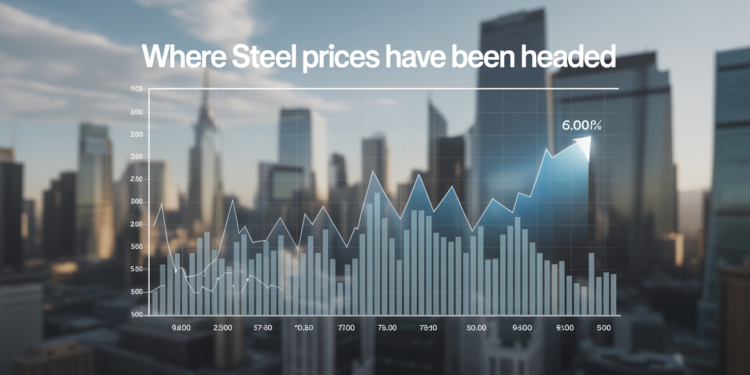If you’ve been buying or working with steel in the last six months, you’ve probably noticed the price tag hasn’t exactly stayed still. Between policy shifts, supply chain reshuffling, and some uneven global demand, steel pricing has been anything but predictable. Whether you’re in construction, manufacturing, or just trying to get a quote that holds for more than a week, you’ve likely felt the impact firsthand.
Let’s take a closer look at what’s happened in the steel market from late 2024 through the first half of 2025—and why a solid relationship with a steel supplier might be your best defense when the market starts swinging.
Steel Prices Spiked to Start the Year
Coming out of 2024, steel prices started climbing fast. By March 2025, hot-rolled coil in the U.S. was hovering around $935 per ton, up significantly from the $675 range just a few months prior. Nucor and other major producers raised base prices steadily during that period, reacting to a mix of supply concerns and regulatory changes.
Much of the volatility stemmed from renewed U.S. tariffs. In March, the federal government reimposed and expanded Section 232 tariffs on steel imports. Then, by early June, those tariffs doubled—from 25% to 50% on some steel categories. That sent a ripple through global supply chains. Buyers who depended on imports moved fast to place orders before the tariffs kicked in, pushing demand (and prices) up in the short term.
While this move was aimed at protecting U.S. steelmakers, it also created some challenges for businesses trying to plan projects or restock inventory without blowing up their budgets.
Europe & Asia Felt the Aftershocks
The effects of U.S. tariffs didn’t stop at U.S. borders. European markets saw a sharp uptick in imports as steel shipments originally meant for the U.S. got rerouted. According to the Financial Times, some EU steel categories saw import volumes jump by over 1,000% compared to the previous year. That much extra supply led to steep price drops in some areas—up to 88% in a few cases.
On the other side of the world, South Korean and Chinese steelmakers were also hit with uncertainty. Stock prices for several large Asian producers fell in early June after it became clear that access to the U.S. market would be more limited. China, which has been pulling back on domestic construction activity, was already seeing a slowdown in steel demand. S&P Global projects that the country will produce under 1 billion metric tons of steel in 2025—a notable decline from previous years.
Prices Begin to Ease in the Spring
By April and May, the panic-buying phase started to wear off. With inventories refilled and some of the initial policy shock wearing down, steel prices began to settle.
Hot-rolled coil in the U.S. dropped back to around $864 per ton in June—still high historically, but down a few percentage points from the March peak. TradingEconomics data shows global steel prices dipped about 4.5% in the last month alone. Cold-rolled steel indexes followed a similar pattern: still elevated, but no longer climbing.
Export prices from key markets also declined. Steel rebar prices slipped to about $440 per ton in early June, down from earlier spring highs, according to SteelBenchmarker. For companies that waited to restock, this easing trend offered some much-needed breathing room.
What’s Driving the Market Right Now?
There are a few major factors influencing where prices go from here.
Raw materials like scrap metal, nickel, and chromium have stayed relatively expensive, keeping a floor under steel pricing. In Europe, more producers are switching to electric arc furnaces, which increases domestic demand for scrap. At the same time, export volumes are tighter, which contributes to price pressure.
On the demand side, things are uneven. The EU is facing a fourth year of falling steel consumption, especially in construction. China is scaling back real estate development, while infrastructure investment in places like India and Southeast Asia hasn’t ramped up the way some had hoped. So while there’s plenty of supply, the demand side hasn’t caught up in many parts of the world.
What to Expect Moving Forward
Most forecasts suggest steel prices will continue to drift slightly downward through the second half of 2025, but don’t expect a crash. The market remains sensitive to policy changes, and another tariff update or regional supply issue could push prices back up.
Some analysts believe we’re entering a quieter phase—still elevated from pre-pandemic norms, but without the wild swings of early 2021 or early 2025. A lot will depend on what happens with construction and infrastructure spending globally, especially in countries like China, the U.S., and India.
Why Your Steel Supplier Matters More Than Ever
When the market’s moving quickly—or unpredictably—having a reliable steel supplier can make all the difference. According to Red Lion Inc., a raw metal sourcing company, “a good supplier isn’t just someone who sells you material. They’re often your first line of insight when prices begin to shift.”
Strong suppliers are usually tapped into both domestic and international mill networks, which means they can help you avoid overpaying when one region gets tight. They’re also watching tariffs, logistics delays, and inventory cycles in real time. That kind of intelligence can help you place smarter, better-timed orders.
The best ones will even offer flexible pricing strategies—forward buys, index-linked quotes, or blanket orders—so you’re not stuck chasing spot rates when the market isn’t in your favor.
There’s also the issue of continuity. When prices spike or supply tightens, smaller or less-prepared suppliers may leave you scrambling. Larger, well-connected suppliers are usually able to keep orders moving through alternative mills, port routes, or domestic stockpiles.
Final Thoughts
Steel prices have been on a bit of a rollercoaster lately, and the ride isn’t quite over. After spiking in the first few months of 2025—driven mostly by trade policy—the market has started to cool. That’s good news for buyers looking to re-enter the market, but it doesn’t mean smooth sailing from here on out.
The key takeaway? Timing and strategy matter, especially in a market like this. Working with a steel supplier who understands the bigger picture, has access to diverse sources, and can offer flexible terms is no longer a luxury—it’s a necessity.
In uncertain times, it’s not just about getting steel. It’s about getting it at the right time, from the right source, and at the right price.













































































